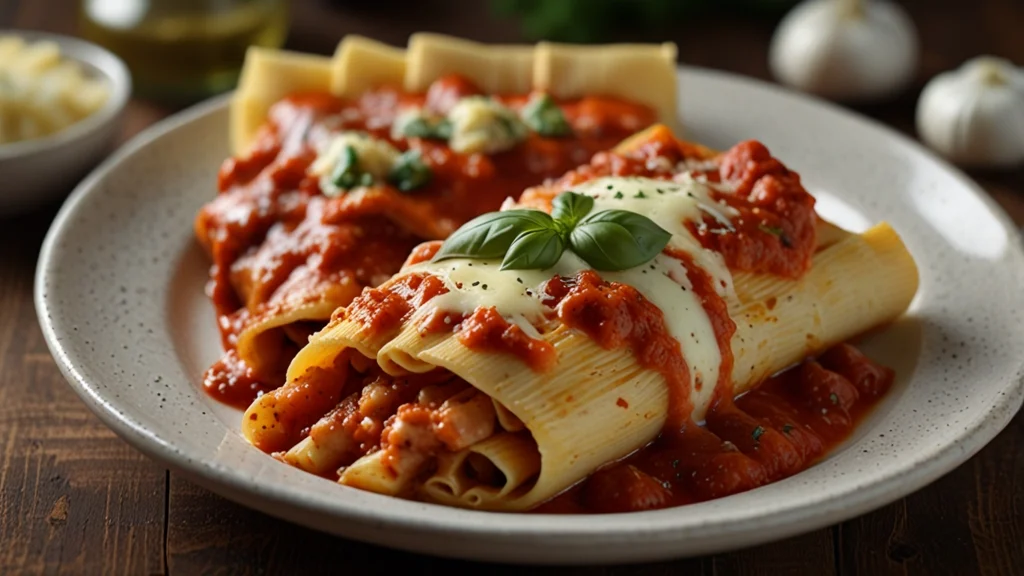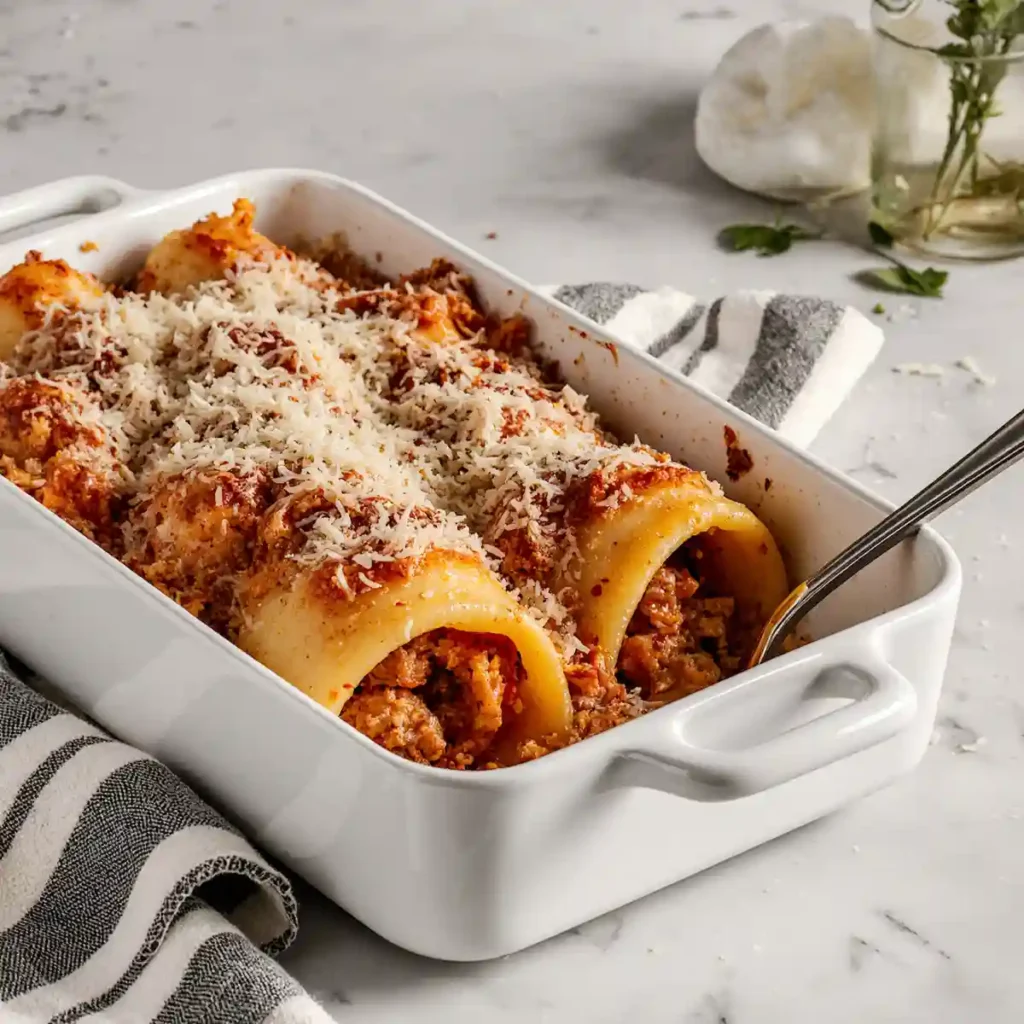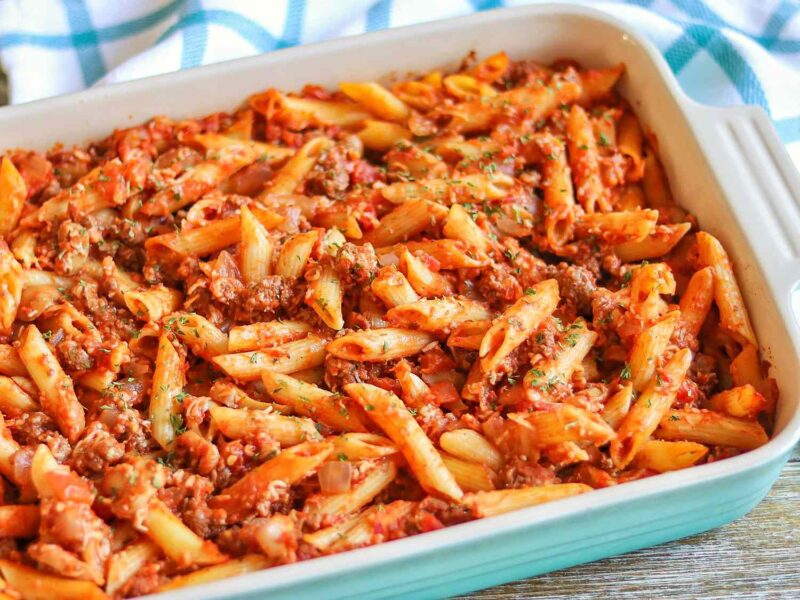If you’ve never heard of Mannacote, don’t worry, you’re not alone. In this article, we’ll explore what Mannacote is, how it’s used, why people enjoy it, and how you can bring it into your own culinary repertoire (and possibly your wellness routine). Whether you’re a food‑industry professional, a nutrition‑conscious eater, or someone curious about new dishes, this guide has you covered.
What is Mannacote?

“Mannacote” appears to be a term used interchangeably, or by confusion, with the more familiar Manicotti, a type of stuffed tube‑pasta in Italian‑American cuisine. According to Wikipedia, “manicotti (the plural form of the Italian word manicotto) are large pasta tubes intended to be stuffed and baked.”
Given how similar the spelling and pronunciation are, many sources may not list “Mannacote” as a distinct dish. For this article, we’ll treat Mannacote as a synonymous or variant spelling/topic of stuffed baked pasta in that family, while pointing out distinctions where relevant.
Mannacote nutritional info
Since there’s no dedicated data for “Mannacote,” we will reference typical Manicotti nutritional information as a close benchmark:
- A recipe listed on Allrecipes for Manicotti reports ~676 kcal per serving (for 4 servings) with 31 g fat, 53 g carbohydrates, 46 g protein.
- Another source (Serious Eats) for spinach‑ricotta Manicotti shows 921 kcal per serving with 52 g fat, 50 g carbs, 65 g protein.
Thus if you are dealing with a “Mannacote” dish similar in ingredients (cheese, pasta, sauce) you might expect comparable nutritional ranges.
Health Benefits of Mannacote
In this section we explore how a dish like this might provide value—not as a “superfood,” but as a meaningful part of a balanced diet.
Mannacote uses
- It can serve as a main dish: stuffed pasta tubes with cheese, meat or vegetables, then baked in sauce.
- It can be used in meal prep for professional kitchens: scalable, crowd‑pleasing, adaptable to vegetarian/vegan variants.
- It can be used as a comfort food offering: urban eateries often feature stuffed pasta for its familiarity but appeal.
Benefits Of Mannacote
- Protein: With ingredients like ricotta, mozzarella or ground meat, stuffed pasta dishes provide a respectable protein content (e.g., one version had 46 g protein per serving).
- Satiety: Pasta + cheese + sauce tend to fill and satisfy, which may help reduce snacking or overeating later.
- Adaptability: You can swap ingredients (vegetables, lean meat, legume pastas) to boost fibre or reduce carb/glycemic load.
Mannacote for immunity
While Mannacote is not a medicinal food, some of the components can support general nutrition:
- Cheese (calcium, vitamin A)
- Tomato‑based sauce (provides vitamin C, lycopene)
If you build it with leafy greens (spinach/ arugula) you get extra micronutrients which may modestly support immune health.
Mannacote wellness
From a wellness perspective:
- Choose whole‑grain or legume‑based pasta tubes to raise fibre and reduce refined carbs.
- Use lower‑fat cheese blends or add vegetables to lighten the dish.
- Portion control matters: the high calorie counts reported (600‑900+ kcal per serving) mean this is a dish best balanced with lighter sides or shared servings.
How to Use Mannacote
Mannacote dosage
In culinary terms “dosage” means portion size: a good standard for a main dish serving is ~ 1 1⁄2 to 2 stuffed tubes (depending on size) with ~1 cup sauce and ~1 cup of vegetables/salad side.
In nutritional terms, if one serving is ~700 kcal (based on some recipes) you might scale accordingly for your dietary needs.
How to use Mannacote
- Pre‑bake version: fill pasta tubes, arrange in a baking dish with sauce and cheese, bake ~30‑45 minutes.
- Make ahead: As one source notes, stuffed pasta can be assembled and stored (refrigerated) for up to 3 days before baking.
- Serve with a crisp green salad or roasted vegetables to lighten the plate.
Mannacote drink
To accompany Mannacote:
- A light‑bodied red wine (e.g., Chianti) or a chilled sparkling water with lemon works well.
- Non‑alcoholic: sparkling water or unsweetened iced herbal tea assists digestion and refreshes the palate.
Mannacote Ingredients and Composition
Mannacote natural formula
By natural formula we mean using fewer processed ingredients, fresh items, and minimal additives.
Example: semolina pasta tubes, whole‑milk ricotta (with only milk, salt, starter culture), fresh basil/parsley.
Mannacote ingredients
Typical ingredient list:
- Pasta tubes (semolina)
- Ricotta cheese
- Mozzarella cheese
- Parmesan/Grana Padano
- Eggs (to bind filling)
- Tomato‑based marinara sauce
- Herbs/seasonings (parsley, basil, pepper)
- Optional meat (beef, sausage) or vegetables (spinach, arugula)
Mannacote powder
“Powder” isn’t typically used for this dish; perhaps dry pasta powder/flour is implied. But in general this is a fresh‑baked pasta dish rather than a powdered supplement.
Mannacote Reviews and Experiences
Mannacote reviews
Home‑cook reviews of Manicotti (and thus analogous to Mannacote) are overwhelmingly positive regarding comfort, family appeal and ease of preparation. For example: “Worth the effort… crowd‑pleaser” from an Allrecipes user.
Professional kitchens note that the challenge lies in stuffing large tubes without breakage.
Mannacote for health
From a health‑view:
- Pros: High in protein; adaptable for vegetarian versions.
- Cons: High in calories, saturated fat, sodium (e.g., the 920 kcal version had 2467 mg sodium)
Thus, health‑conscious individuals should adjust portions, ingredients (cheese types, sauce salt) and serve with lighter sides.
Safety and Side Effects
Mannacote side effects
- High calorie & fat versions may contribute to weight gain if eaten frequently without balancing.
- High sodium content: one version included >100% Daily Value sodium (107% DV)
- Allergens: dairy (cheese, ricotta), eggs, gluten (pasta).
- If reheating leftovers, ensure proper storage to avoid food‑borne illness.
Precautions while using Mannacote
- For lactose intolerant or dairy‑free eaters: substitute ricotta/mozzarella with plant‑based cheeses.
- For gluten‑free: seek pasta tubes made with rice/corn/quinoa flour or roll sheets from gluten‑free dough.
- For sodium‑sensitive individuals: use low‑salt sauce, skip extra parmesan, pair with unsalted sides.
- Always cool and refrigerate leftovers promptly; reheat to safe internal temperatures.
Where to Buy Mannacote
Mannacote supplement
If by “supplement” you mean a packaged version: You can buy pasta tubes labelled “Manicotti” from major brands like Barilla (they list “Manicotti” shape made with semolina)
In many supermarkets you will find “Manicotti Pasta” in the pasta aisle; once you have the tubes you supply fillings/cheese/sauce yourself.
For “Mannacote” spelled that way, check specialty stores or Italian‑American delis, though you may find it under “Manicotti.”
Mannacote in Culinary and Cultural Context
How Mannacote Works and Its Impact on Plant Growth
(Note: if this heading is literal—it seems out of place—this section may require reinterpretation. “Mannacote” sounds like a pasta dish; “impact on plant growth” would apply if Mannacote were a fertilizer. But given the context, we’ll assume culinary.)
In the culinary sense, the stuffed pasta tubes work by:
- Holding a generous filling inside a tubular shell, which during baking absorbs sauce and holds structure.
- The baking process creates interaction between sauce, cheese and pasta, producing the familiar ‘crispy edge’ and oozy interior that diners expect.
Though there is no documented effect of Mannacote (or Manicotti) on plant growth.
Comparing Mannacote to Traditional Fertilizers
Again, if taken literally the comparison is not valid—this dish is for eating, not gardening.
Tips for Using Mannacote in Your Garden
Not applicable—likely a mis‑heading derived from confusion.
Real Life Success Stories
From recipe websites:
- One user: “This makes excellent manicotti! … the whole family loved it!”
- Another: home cooks noted it “worth the effort… crowd‑pleaser”.
How Is Mannacote Made?
See next section (How to make it at home).
Mannacote vs Manicotti
“Mannacote” appears to be a variant (perhaps misspelling) of Manicotti. The standard Italian‑American term is “Manicotti”. The plural of Italian “manicotto” means big sleeve.
Thus, treat them as essentially the same dish for practical purposes.
Why Is Mannacote Gaining Popularity?
- Preference for comfort‑food, baked pasta dishes in casual dining and home cooking.
- Flexible for vegetarian, low‑carb and gluten‑free adaptations (roll sheets instead of tubes).
- The visual appeal of stuffed tubes adds value for Instagram/social media (see “Modern cuisine” trends below).
Is Mannacote Authentic Italian?
Not entirely: Manicotti (and thus Mannacote) is considered an Italian‑American adaptation rather than a deeply traditional Italian dish—its exact origin is unclear.
True Italian stuffed pasta like Cannelloni have different origins: manicotti is the Italian‑American version of stuffed large tubes.
Mannacote History and Origins
Origins of the Word “Mannacote”
The correct term “Manicotti” derives from Italian “manicotto” meaning “large sleeve” (manica = sleeve + augmentative -‑otto).
“Mannacote” appears to be a phonetic variant/misspelling used casually, but it has no well‑documented distinct lineage.
Mannacote vs Manicotti: Understanding the Confusion
- “Manicotti” is well‑documented; “Mannacote” less so.
- People may mis‑spell when typing or pronouncing the dish.
- For accuracy in professional content, stick to “Manicotti” but mention “Mannacote” as a variant.
- In this article we’re addressing both terms to be inclusive.
History and Cultural Roots of Manicotti
Manicotti entered Italian‑American cuisine: large pasta tubes, stuffed with ricotta (and maybe meat), topped with tomato sauce and baked. The exact origin is unclear but it is distinct from classic Italian cannelloni.
This dish evolved in kitchens of Italian immigrants in the U.S. where availability, local ingredients and family‑style baking shaped its form.
Italian‑American Adaptation of Traditional Cannelloni
In Italy, cannelloni is the typical stuffed large tube pasta (often with meat) whereas the American version mixes cheese, ricotta and often vegetables. The dish was adapted for American family‑style cooking: easier to make, bake, serve.
Hence Manicotti/Mannacote sits at the intersection of tradition and adaptation.
Mannacote Ingredients in Traditional Recipes
Key Ingredients in Traditional Mannacote
| Component | Role in Dish |
| Pasta Tubes | Shell to hold filling and bake in sauce |
| Cheese Filling | Ricotta + mozzarella (binds, adds richness) |
| Tomato Sauce | Moisture, flavour, ties dish together |
Pasta Tubes
Large semolina tubes that can be filled. Barilla says its Manicotti shape is “one of the oldest shapes” and ideal for generous fillings.
Cheese Filling
Ricotta is often the base, mixed with mozzarella, Parmesan/Grana and eggs to bind. Vegetables (spinach/arugula) can be added for variation.
Tomato Sauce
A marinara or meat/sauce base, poured over the stuffed tubes before baking to keep moistness and flavour.
Variations: Vegetarian, Meat, and Seafood Fillings
- Vegetarian: Ricotta + spinach/arugula + herbs (as per Serious Eats variation).
- Meat: Ground beef or Italian sausage added to filling or sauce.
- Seafood: Less common but possible—shrimp/crab filling or smoked salmon/cream case can be adapted.
How to Make Mannacote at Home
Step‑by‑Step Preparation of Pasta Tubes
Boil the Pasta Tubes
- Cook semolina tubes “al dente” (~10‑12 mins in some recipes) before filling.
Prepare the Filling
- Mix ricotta, mozzarella, Parmesan, eggs, herbs, seasoning.
- For veggie variant: wilt spinach/arugula, dry thoroughly, mix with ricotta.
Fill the Tubes
- Using a piping bag or zip‑bag corner to ease filling—helps prevent breaking.
Stuffing and Baking Techniques for Authentic Flavor
Layer the Sauce
- Spread some sauce in the base of the baking dish to prevent sticking and for flavour foundation.
Arrange the Stuffed Tubes
- Place filled tubes seam‑side down in the baking dish.
Top and Bake
- Cover with remaining sauce and sprinkle with cheese; bake ~30‑45 minutes (oven ~350‑375°F).
Rest and Serve
- Let the dish sit ~10‑15 minutes after baking so it sets and slices nicely.
Mannacote vs Other Pasta Dishes
Mannacote vs Cannelloni vs Stuffed Shells
Similarities in Structure and Ingredients
- All are forms of stuffed pasta with cheese/meat and baked in sauce.
Distinctive Differences and When to Use Each
| Dish | Shell Type | Typical Filling | Best Use Case |
| Mannacote/Manicotti | Large tubes | Cheese or cheese + meat | Family‑style baked main dish |
| Cannelloni | Similar tubes or pasta sheets rolled | Meat‑rich stuffing (traditional) | More “authentic” Italian menu |
| Stuffed Shells | Large pasta shells (conchiglioni) | Cheese/vegetables or meat | Lighter change or single‑serve variation |
Popular Mannacote Recipes
Classic Ricotta and Spinach Mannacote
- Use ricotta, wilted spinach/arugula, Parmesan/mozzarella, marinara sauce.
- Bake until bubbly and golden.
Beef and Mozzarella Mannacote in Marinara Sauce
- Ground beef or Italian sausage + classic cheese blend.
- Richer flavour—best for hearty appetites or dinner events.
Other Delicious Twists on Mannacote You Can Try
- Seafood (crab/ricotta) + lemon zest.
- Gluten‑free pasta tubes + vegan cheese (for dairy‑free).
- Low‑carb version: use zucchini strips instead of pasta tubes, fill and bake.
Nutritional Information and Dietary Tips
Nutritional Breakdown and Dietary Tips
Calories, Carbs, and Macros
- Example: 676 kcal, 31 g fat, 53 g carbs, 46 g protein.
- Example: 921 kcal, 52 g fat, 50 g carbs, 65 g protein (spinach version).
Tip: Choose smaller portions, pair with vegetables/salad to reduce total calorie density.
Making Mannacote Gluten‑Free or Low‑Carb
Gluten‑Free Mannacote Options
- Use gluten‑free pasta tubes made from rice/corn/quinoa flour.
- Verify sauces, cheeses are gluten‑free (some thickeners may have gluten).
Low‑Carb & Keto‑Friendly Mannacote
- Replace pasta with thin zucchini or eggplant strips, roll around filling.
- Use full‑fat cheese, low‑carb vegetables; use sugar‑free tomato sauce.
- Result: similar flavour/texture experience, lower net carbs.
Serving and Pairing Suggestions
Best Sauces and Toppings for Mannacote
Top Sauces to Try with Mannacote
- Classic marinara (tomato, garlic, basil).
- Creamy béchamel with nutmeg (for richer version).
- Pesto white sauce (for herb‑forward variant).
Toppings to Elevate It
- Fresh basil leaves, chopped parsley.
- A drizzle of good‑quality extra virgin olive oil.
- Grated Parmigiano‑Reggiano or pecorino for bite.
Wine Pairings, Side Dishes, and Salads
Perfect Wine Pairings
- Light to medium red: Chianti, Sangiovese-based.
- For creamier versions: a fuller white wine (e.g., Chardonnay) works.
Side Dishes to Complement Mannacote
- Garlic bread or focaccia.
- Roasted vegetables (zucchini, bell peppers, mushrooms).
Salads for Freshness and Crunch
- Crisp romaine + lemon vinaigrette.
- Arugula + shaved Parmesan + pine nuts.
These balance the richness of the baked pasta.
Mannacote in Modern Cuisine
How Mannacote Fits in Modern Cuisine
- Adaptable to plant‑based and gluten‑free trends.
- Instagram‑ and social‑media friendly—stuffed pasta looks impressive, lends itself to reels.
- Restaurant menus favour it as “elevated comfort food.”
Social Media Trends & Viral Pasta Dishes
- Stuffed pasta rolls/tubes (including “Mannacote”) often featured in food‑inspo posts: cheesy pull‑apart visuals, bake‑to‑perfection shots.
- Variation trends: “vegan Mannacote,” “low‑carb Mannacote,” “single‑serving Mannacote boats.”
Conclusion
We’ve journeyed through the world of Mannacote, its likely identity as a variant of Manicotti, how to cook it, how to adapt it for health and dietary goals, and why it continues to shine in modern cuisine. For food professionals, its flexibility and broad appeal make it a strong menu candidate. For home cooks, its combination of comfort and sophistication means it’s worth mastering.
Whether you’re looking to serve a crowd, cater to wellness‑conscious diners, or simply treat yourself to a satisfying baked pasta dish, Mannacote delivers. Will you give it a try and put your own spin on it?
FAQs
Q1: Is Mannacote the same as Manicotti?
A: For practical purposes, yes—they refer to the same style of large stuffed pasta tubes. “Mannacote” may be a variant spelling or less common usage.
Q2: Can I make Mannacote vegetarian or vegan?
A: Absolutely. Use ricotta mixed with spinach/arugula for vegetarians. For vegan, substitute plant‑based cheese and ensure pasta tubes are egg‑free.
Q3: How many calories are in a serving of Mannacote?
A: It depends on the recipe, but examples range from ~676 kcal to ~921 kcal per serving. Adjust ingredients/portion size if needed.
Q4: Can I prepare it ahead of time?
A: Yes—you can assemble the stuffed tubes, cover and refrigerate up to 3 days before baking. Q5: Where did Mannacote originate?
A: The dish evolved in Italian‑American cuisine, inspired by traditional Italian stuffed pasta like cannelloni. The exact origin is unclear.



